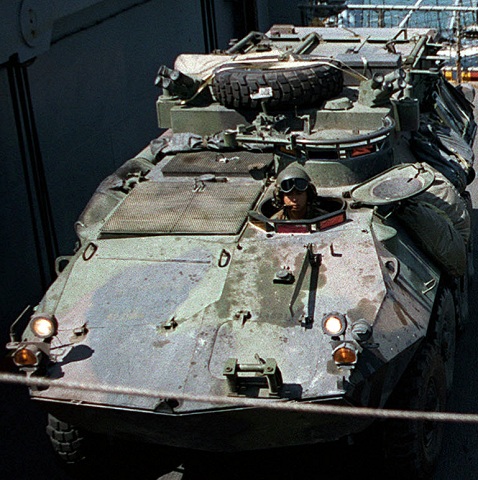
LAV-L at Yermo Annex of Marine Corps Logistics Base Camp Barstow, California.

The raised roof is apparent on this vehicle compared to other types of LAV, and the large roof hatch has been provided with a folding cover. The rear doors have been modified so that there is no longer a frame around each one, and consequently entrance to the rear compartment has been made easier. The smoke grenade launchers can be seen on top of the roof at the front corners. Neither the hoist nor the folding platform for the hoist operator are mounted, but the hoist would normally be stowed across the rear of the roof and the platform would be just forward of the left-hand taillight group. (Picture taken 25 Aug 1993; available from the National Archives.)

The recovery crane on the LAV-R is immediately obvious, and its hull roof is raised at a more rearward point (behind the crane mount) compared to that of the LAV-L that is ironically towing it. The stabilizing outriggers are mounted between the second and third axles, and the hoist operator platform on the LAV-L can be seen just in front of the taillight under the duffle bag. These vehicles were in northern Saudi Arabia during operation Desert Storm. (Picture taken 1 Feb 1991; available from the National Archives.)

The rear doors are open on this machine, allowing us to see the large opening created by the overlapping frameless doors. The cargo compartment roof hatch is open as well. (Picture taken 1 Mar 2003 by LCpl Andrew P. Roufs; available from the National Archives.)

The driver's and commander's stations are apparent in this view of the LAV-L. To the driver's right is the engine's large air inlet grille, behind this is the smaller air exhaust grille, and between them is the radiator filler cap. The engine cover hatch can be seen in front of the inlet grille, and the winch cover is just behind the fair lead on the front slope's left side. The hoist is not mounted on this vehicle, either. This vehicle is being driven by PFC Barton and is on the USS Tarawa during Deep Strike '97. (Picture taken 1 Aug 1997; available from the National Archives.)